LifeSpan TR1200-DT3 Treadmill Desk Review
- Lab tested
Like most reviews sites, our editorial staff and laboratory testing expenses are partially offset by earning small commissions (at no cost to you) when you purchase something through those links. Learn More

Overview
| Review Summary |
Yesteryear’s most popular office treadmill, the advent of the TR1200-DT3 back in 2011 helped to kick off the treadmill desk revolution. The original design had a great reputation for being a solid middle-of-the-road offering. Not too expensive and relatively reliable for a typical single-user, home office usage profile. The company had a decent service network and to the degree that it was as good as anyone else’s, an industry leading warranty. Things started to change with a redesign cycle around 2018, however, when the founders and eventually the entire senior management team would see the last of their days with the company after nearly 20 years. Lifespan would be overtaken by Strength Master of Taiwan, its exclusive manufacturing partner and largest creditor. In the ensuing years, and particularly through the pandemic, the company went through a series of component quality reductions and price increases. As a consequence of the management departures, plus a lot of complaints we found online about customers having a hard time getting service for their units, we sadly have to revoke our unreserved recommendation of Lifespan’s treadmill desk products. Better units are significantly more expensive, though, so if you’re budget-constrained the TR1000, TR1200 or TR5000 might still be your best bet for the money. |
|---|---|
| MSRP / List Price | $1699.99 |
| Street Price |
Most recently listed at $1,458 on Amazon
|
| Shipping |
Ships via freight carrier. |
| Warranty |
Frame: 10 Years | Parts: 2 Years | Labor: 1 Year |
| Controller |
The TR1200 is only sold with Lifespan’s “Retro” desktop controller for this price. Membrane keypad type with just the basic LED readouts: speed, time, distance, step count and calorie burn. Users can upgrade to the new OmniHub LCD display controller for an additional $100. |
| Construction |
3/4″ phenolic deck with 6 elastomeric compression pads. |
| Weight Capacity |
350 Lbs. |
| Walking Belt Size |
20” W x 50″ L |
| Top Speed |
4 mph |
| Dimensions |
Treadmill: 63″ L x 28.5″ W x 7.25″ H |
| Horsepower/RPM |
2.25 HP Continuous Duty Motor |
| Connectivity Features |
While the controllers have Bluetooth transceivers they only (somewhat) work with the LifeSpan Club App, which is designed for gym equipment and has a rating of 1.2 out of 5 stars on the iOS App Store. |
| Product Weight |
Treadmill: 114 lbs. |
| NEAT™ Certified by Mayo Clinic |
No |
| Competition |
Compare to All Top-Rated Office Treadmill Desks
|
| User Reviews | See verified reviews on Amazon |
| Where to buy |
Buy on LifeSpan Buy on Amazon |
Rating
| Ease of Assembly | |
|---|---|
| Reliability | |
| Customer Experience | |
| Quality and Aesthetics | |
| Ergonomics | |
| Innovation | |
| Value | |
| Positives | The legacy TR1200-DT3 is unquestionably the most popular treadmill desk ever made, with many thousands of units in the field. It was a reasonably well-built machine for light use. While not the OG (that was the outlandishly overpriced and poor quality Steelcase Walkstation) it was the first treadmill desk "for the rest of us." At the time it was the first truly affordable legit under-desk treadmill. Of the few remaining office treadmills on the market today, the only cheaper unit on the market is Lifespan's own TR1000, which is priced $200 lower. We don't know which if these two models are the top seller today but combined they are super popular, still dominating market share of the office treadmill industry, because better units sell for $2,000 to $3,000. |
| Negatives | Recent changes at the company have forced us to remove our "buy" recommendation from this company's products. The TR1200-DT3 has been severely cost reduced to the point of significantly lowering its reliability, and this was done surreptitiously without changing the model name. Thinner steel means more flex in the frame and more potential problems with belt tracking. We found quite a few complaints about general difficulty in reaching customer service for repairs in past periods, which the company claims to no longer be the case. As company ownership shifted to Taiwan and the US management team walked out the door, systemic problems have arisen at Lifespan that seem to have peaked during the height of the pandemic. While the new Omni Hub Smart Controller (+$100) cures some of the user interface issues most complained about with the rebranded brick-style "Retro" desktop controller, the smartphone app has so many problems that it's barely with the upgrade just to get Bluetooth. Ever since the units were redesigned for cost reduction a few years ago their reliability seems to have come down, while their prices have gone up about 40% (and that's down from pandemic highs). |
Bottom Line
The Lifespan Fitness Backstory
The founding editors of this website got the gumption to launch WorkWhileWalking (and WorkWhileStanding, which eventually merged into this site) back in 2012, specifically because Lifespan Fitness made a bold entry into the treadmill desk marketplace that finally legitimized it. Prior to their arrival, there were only three options for someone who wanted to have a treadmill desk: a) Steelcase’s insanely overpriced and unreliable Walkstation Treadmill Desk, b) the now-defunct, incredibly poorly-made TreadDesk or Signature Treadmill Desk alternatives to the $5000 Steelcase unit, or c) taking the DIY route by hacking a rehab treadmill into a reasonably reliable, slow-speed treadmill desk.
Lifespan was the first legit player to commercialize the treadmill desk with a reasonably-priced range of products to suit almost every customer type. These included the flagship TR1200-DT3 office treadmill, the lower-cost TR800-DT3 and the heavy-duty TR5000-DT3, as well as the DT5 and DT7 integrated treadmill desk workstations with their manually and electrically height-adjustable standing desks, respectively. Tens of thousands were sold to corporations, government, education and residential home offices over the past decade. Lifespan treadmill desks would regularly appear in TV shows from The Good Wife to Alpha House.
Lifespan’s foray into active office workstations eventually attracted many competitors into the field (see our round-up review of all the under-desk treadmill bases and all the top-rated treadmill desk systems); most of which, at this stage of the game, have already joined the Dead Pool. Quite a few big brand names in cardio equipment and a few misguided startups chased this shiny object only to find out that building and marketing a good treadmill desk would take a lot more than just removing the large pedestal console and replacing it with a desktop controller to make room for an actual desk. In 2015 iMovR launched the first premium-grade, enterprise-class ThermoTread GT treadmill base, and a wide array of integrated treadmill desk systems build around it such as the Lander Treadmill Desk, giving Lifespan its first real competition. In 2022 iMovR ended production of the ThermoTread GT due to supply chain challenges and partnered instead with another competitor, InMovement, to bring out the iMovR Unsit treadmill base.
Lifespan’s DNA was definitely formed in the crucible of sports equipment development, though, and this really showed in their rather pitiful offerings on the desk side of the treadmill desk combo. When asked, ergonomists shunned all treadmill desks for a long time because the Lifespan DT5 and DT7 rendition were all they’d ever seen at a trade show. Eventually, Lifespan caved and started to offer an ever-changing variety of standing desk alternatives, sourcing commodity-grade options from their factory peers in China and just bundling them with their treadmill bases. The DT5 and DT7 were removed entirely from the Lifespan website at one point, though they appear to have recently returned.
At present, the only desks sold in bundles with the treadmill bases on Lifespan’s website are the generically-named Lifespan Fitness Standing Desk, which we’ve reviewed separately. Like the DT5 and DT7 desks, the new “Power Desk” line that’s based on this desk commits the same original ergonomic sin. Between the user and their keyboard is situated a deep forearm resting cushion with an embedded console for controlling the treadmill. This forces the user into a shoulder-forward posture as they type with their upper body weight resting on their forearms to maintain stability. At least that’s how the company liked to demonstrate it at trade shows and in videos. Lifespan Fitness’ desk offerings have always been incompatible with the installation of ergonomic keyboard trays, especially on the models using the old-school DT5 and DT7 desk bases.

While the company has never had any certificated ergonomists on staff, and always knew vastly more about working out on cardio equipment than they ever did about office workstation ergonomics, the current marketing team understands even less. Shockingly less. Perusing some of their recent social media postings we found numerous publicity shots, like this one here, that curves our spines just looking at them. Here we have a TR800 “Classic” treadmill desk set to a fixed sitting height, with a birch standing desk converter on top of it. For all the hardware in this photo, there is no ergonomic monitor to hold up the display so the user’s neck is craning down, while the model is fake-typing in a completely unergonomic posture. What exactly is the point of putting a converter on top of an adjustable-height desk? More importantly, what is the point of using a treadmill desk in such a way as to create multiple potential ergonomic injuries? What is the point of setting a treadmill desk at sitting height, not walking height? So many questions.
Another tipoff that Lifespan’s marketing team doesn’t know the first thing about office fitness is that they’ve rebranded all their standalone treadmill bases from “-DT3”, e.g. the TR1200-DT3 is now the TR1200-Glowup. But the term “glowup” really gets us, because as we’ve long said, “if you’re sweating while treadmill desking, you’re doing it wrong.”
Lifespan marketing materials often refer to walking at your desk as “a workout” instead of what it’s supposed to be: introducing healthy movement into your sedentary work routine. Sweating at your desk is anathema to the goal of treadmill desking, where you want that extra oxygen going to your brain, not your muscles. If you need some cardio exercise you should get it at the gym, not the office. As many years of Mayo Clinic research has supported, the goal is always to keep your heart rate and metabolic rate in the NEAT Zone. Perhaps this is one reason Lifespan Fitness never sought NEAT Certification; they’ve always left the top-end speed of their under-desk treadmills at 4.0 mph, way higher than the recommended 1-2.5 mph speed most office workers use, in order not to turn away customers who literally wanted to jog at their desks—with all the implied injury risks that entails.
Change of Command
Originally founded by ex-IBM sales account manager Pete Schenk after the dot-com bubble burst in the summer of 2000, the company ran with his hand on the tiller for 19 years. Not the actual manufacturer of any of these products, Salt Lake City, Utah-based Lifespan Fitness (technically, Park City Entertainment) had negotiated the exclusive distribution rights in North America and Europe for gym equipment products, and later treadmill desk and cycle desk products—all manufactured by Strength Master, a mid-tier manufacturer of cardio fitness equipment based in Taiwan and China.
It’s unclear how much ownership control the Taiwanese management team had over Lifespan prior to Schenk’s departure, but contrary to impressions the US-based company liked to put out to the world, the Utah contingent never really had much design input into the products they sold. This led to challenges over time. The company was never really in charge of its own destiny, and only had the management bench strength to be a capable distributor, not an actual technology innovation leader in the industry. The company that is always pushing the technology and ergonomic research on treadmill desks had always been iMovR. (iMovR also partnered with The Mayo Clinic to publish the only solid research on things like How Many Calories Can You Really Expect to Burn Using a Standing Desk or Treadmill Desk?)
Product reliability was always a concern because the Taiwanese factory wanted to make one treadmill base for both cardio fitness and office workstation applications. In fact, the service manuals for the office treadmills and running treadmills (e.g. TR1200 and the TR1200i) are exactly the same. This instigated a fundamental conflict as to where to set the gearing ratios on the motor-flywheel-pulley-head roller power transmission system. The consequence of this is that the office treadmills have never had sufficient torque at low speeds, like the 1-2 mph speed that most workstation users are walking at. This led to a shortened useful life span for the costly motor, and mounting warranty claims over the years. (We get into all the nerdy details on this issue in our primer on Do Treadmill Desk Weight Ratings Really Matter? if you want to learn more.)
From interviews with Lifespan executives over the years we learned that the company was never really on very solid financial footing. The tariffs imposed on China only affected some of the products that Strength Master made in their Chinese factory. But the pandemic, sadly, appears to have dealt a rather significant body blow to the company. In March of 2019, insiders tell us that Schenk simply “walked away from the company,” purportedly after some internal scandal over nepotism. Clearly, the Taiwanese are in charge of Lifespan Fitness today, with the daughter of Strength Master’s CEO moving to Utah to oversee the operation as its new CEO. In 2019, we learned from a wave of departing employees that they were told by the company that they were all being summarily laid off, without warning, “due to covid.”
Ever since Schenk’s departure, the company’s reputation has taken a bit of a hit, sad to say. Many product descriptions, detail photos and specifications have been dumbed down, well-hidden or completely removed from the website. It’s sometimes hard to get a human on the phone. Lucy the live chatbot is badly programmed and doesn’t know how to answer a single question about the treadmill desk products, only classroom products and gym equipment. We’ve read numerous user complaints on various networks like the BBB about customers not getting any kind of response on warranty claims and other issues. Places, that is, where Lifespan couldn’t scrub out most of the bad reviews (to be fair, most manufacturers do the same). Despite assurances to the contrary from the new management, Lifespan Fitness doesn’t feel like the same company we knew so well in the formative years of the treadmill desk industry.
Onto the review of the TR1200-DT3 / TR1200-Glowup….
The Difference Between “Car Chassis” and “Truck Chassis”
Automotive reviews speak in terms of “car chassis” versus “truck chassis” heritage. We segregate the bottom-tier treadmills (TreadDesk, RebelDesk and Exerpeutic) from the mid- and top-tier units on a similar basis – by the quality of their components. Broadly speaking, units that sell for under $900 are generally derived from cheap, consumer-grade equipment meant to be used sparingly and for short durations throughout the week. (Ironically, the circa-2007 treadmill base used in the $4,459 Steelcase Walkstation is of the same breed.) An office treadmill is a piece of equipment you plan to use for hours most days, so you want to make sure the one you get is made from quality gear that you can rely on and be proud to own.

The original TR1200’s 131 lb. frame was substantially stronger and better made than TreadDesk’s lightweight 101 lb. frame and Rebel’s featherweight 88 lb. frame (see our review of the Rebel Desk for picture comparisons of frame construction quality). Frame flex and creaking are both problems we noticed with the Rebel, and TreadDesk has had similar problems reported. Cheapskating on the frame weight played a significant part in why those two companies are no longer around. The LifeSpan TR1200 had more metal and reinforced rectangular tubing than its cheaper competitors.
And why is this important? Rigidity is paramount in a treadmill. Excess flex in the frame can lead to early degradation of the walking deck, which leads to an increase in friction, noise, and power consumption. If allowed to go on for long enough, total motor and/or controller failure can ensue. A solid walking deck, like on the original TR1200, ensured years’ worth of walking longevity.
Unfortunately, all that changed a few years ago when the founders of Utah-based Lifespan Fitness left the company and the Taiwanese factory took over. Surreptitiously, without even changing the model names, they put all the TR Series under-desk treadmills on a weight loss program. They dropped the TR1200’s weight down from 131 to 113 lbs to save on metal and other vital components. This comports with increased reports we found online from users experiencing difficulty with belt tracking and other service issues since the changes were made to the product. In effect, Lifespan changed the construction grade of frame designs on the TR1200 and TR5000 from “truck chassis” to “car chassis.”
What Horsepower Means on a Treadmill Desk
As far as the TR1200 specifically is concerned, what the free market eventually revealed is what our review staff has been writing about for over a decade, that pulling a dead weight across a treadmill deck at 1-2 mph requires far more low-speed torque from a motor than when a runner is kicking the belt in the same direction the motor is turning. The force required to overcome the friction between the belt and the deck is immense, and running treadmills just aren’t geared for it. The result is always the same: premature motor failure or controller board failure. In other words, a user planning to walk at 1-2 mph should also plan to spend substantially more on a stronger motor and drive train than they would on a cardio treadmill if they want it to last. We go into the engineering reasons behind this in our primer on treadmill powertrains.
Lifespan has long been one of those treadmill manufacturers that lie about their weight ratings. There are no industry standards to speak of, so weight ratings are often what the manufacturers’ marketing departments conjure up, which is something we’ve always focused on proving in actual lab testing when we’ve reviewed these units. Rare is a company like iMovR that conducts both finite element analysis (FEA) on the design of their treadmills and months-long independent testing using specialized equipment.
LifeSpan differentiates its three models by weight rating and recommended number of hours of daily use. On their own website, the TR800 Glowup is rated for 215 lbs and 3 hours of daily use; the TR1200 is rated for 350 lbs and 6 hours of daily use, and the TR5000 for 400 lbs and 9 hours of daily use. The “hours of daily use” rating has little bearing on reality.
In the real world, one must account BOTH for the weight of the user(s) and the frequency of preventive maintenance. If a 175 lb. user bought a TR800 and never lubricated the deck it would eventually fail. On the other hand, a 250 lb. user who routinely sprays a little silicone oil between the deck and belt to keep their TR1200 well-lubed is going to have something that will last for many years. According to treadmill engineers on our staff there is no direct correlation between hours of continuous use and the capabilities of the powertrain; this seems to have been a ploy devised by Lifespan’s marketing team to guide consumers up to higher priced units if the machines were going to be heavily used.
A Controller More Fit for the Gym Than the Office
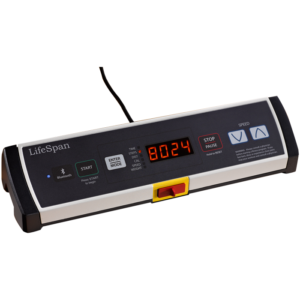 That’s how we’d describe the aesthetics and haptics of the desktop controllers Lifespan puts on their office treadmill bases. The “Retro” console, which has been the most commonly sold since the inception of these under-desk treadmill bases more than a decade ago, is your typical desktop brick. It has a simple LED display and “bumpy” membrane buttons, and has all the basic functions you would expect on a treadmill. You can track distance, time, speed, calories burned, and steps taken. It even has a convenient USB port on the back that lets you charge your cell phone.
That’s how we’d describe the aesthetics and haptics of the desktop controllers Lifespan puts on their office treadmill bases. The “Retro” console, which has been the most commonly sold since the inception of these under-desk treadmill bases more than a decade ago, is your typical desktop brick. It has a simple LED display and “bumpy” membrane buttons, and has all the basic functions you would expect on a treadmill. You can track distance, time, speed, calories burned, and steps taken. It even has a convenient USB port on the back that lets you charge your cell phone.
However, the LifeSpan controller lacks the more advanced functionality users would want for their office treadmill, and the requirement of long button pressing sequences to switch display modes or restart the treadmill can get cumbersome. The controller can’t track the walking stats of more than one user, and doesn’t measure time spent off a treadmill, when you’re sitting or standing.

The original desktop brick controller used to have a Bluetooth sync button for uploading your stats into the LifeSpan Fitness Club Software, but it never worked correctly. Lifespan finally removed it and relabeled this controller the “Retro” style. They recently introduced a new “Omni Hub Smart Console” controller, which we have not yet tested in the lab, that purportedly has Bluetooth incorporated. Users can upgrade to this new controller for an extra $100 when buying a treadmill base, or pay $299 to upgrade their existing Retro controller. The OmniHub isn’t a touchscreen but it does feature a larger LCD screen and gym style buttons beneath it. And it has a Bluetooth interface.
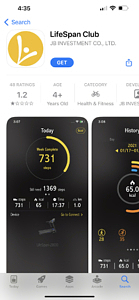 While the new Omni Hub Smart Console has a Bluetooth interface, the Lifespan Club app leaves a lot to be desired, and isn’t going to be particularly useful in the treadmill desking application.
While the new Omni Hub Smart Console has a Bluetooth interface, the Lifespan Club app leaves a lot to be desired, and isn’t going to be particularly useful in the treadmill desking application.Lifespan Fitness in Utah itself does not employ any full-time engineers; the real engineers are all back in Taiwan. This has led to very long-standing problems with some features, especially those surrounding Bluetooth and the smartphone app. The app is really the generic “LifeSpan Club” app that was built around all their gym equipment, not one specifically designed for the needs of the office treadmill user. And at that, it garners all of a 1.2-star rating out of 5, with some pretty harsh reviews.
A recent 1-star user review sums it up pretty well, saying “This app is terrible and many steps backward from the prior version. Aside from the cumbersome setup, many of the instructions are not in English and can’t be changed to English. Also units of measure are inconsistent between metric and imperial so you constantly have to calculate between metric and imperial when entering data….” it gets worse from there. This user added an update, saying “it’s been months since my review and the app still does not work. I’ve contacted support numerous times and the company seems unmotivated to either fix this app or return the old app that worked perfectly. I wish I could return this treadmill and get a competitor product. This company is unfazed by their low quality and user feedback.”
So while the new Omni Hub “Smart Console” is a little easier to use (we especially like the three speed preset buttons, which eliminates the many button taps it takes to restore you favorite speed when using the Retro controller), the Bluetooth feature and related smartphone app seems to be as broken as ever.
Not Well-Suited for the Enterprise Environment
Enterprise customers—large corporations, government agencies, educational institutions and the like—have a particular concern with potential liability when it comes to having treadmill desks on their campuses. While this problem stems from perceptions spawned by YouTube “treadmill fail” videos and not reality (see our article on What Legal Departments Need to Know About Treadmill Desks), as the saying goes, “perception IS reality.” For this reason, the TR1200’s running treadmill-based design never had what it took to achieve widespread enterprise adoption.
While adequate, the membrane buttons on the Retro console is very yesteryear. This is particularly evident in a side-by-side comparison with the touch-screen LCD display console that the ThermoTread GT offered; one that features multiple user profiles, intuitive smartphone-like features and graphics, and has a built-in “click wrap” liability waiver screen to make the corporate legal department very happy. Without this latter feature most corporate, government, and educational institutions would be loath to allow a treadmill desk on the premises, any more than they’d allow an employee to rent a car that didn’t have a liability waiver on its GPS navigation system.
The other problem with all the LifeSpan treadmill units is that their top speeds are set to 4.0 mph, far greater than the maximum recommended 2.5 mph for treadmill desk use. While attempting to capture a little more market share by allowing users to “go cardio” and sweat all over their desks, the downside is that corporate legal departments have been known to order employees to ship LifeSpan treadmills back once they learn they’ve been brought on campus. In fact, UL certification standards have changed since these units were designed a half decade ago, and they might not even pass current safety standards without some redesign.
Home users could care less, and that’s where most TR1200s are destined to be found. This is evidenced, if nothing else, by the fact that all the shipping options are described as “to your residence.”
In Conclusion
After ten years of recommending the TR1200-DT3 (aka TR1200 Glowup) as a very good middle-of-the-road option for the light duty profile single user, we’re saddened to see the degraded quality of its components and the long-standing engineering problems with the Lifespan Club app. When company founders and people with 20 years of institutional memory all leave the company, and the manufacturer all the way in Asia takes over management, bad things can happen.
The issues raised in many user complaints that you won’t find so prominently within Lifespan’s curated users reviews, but you will find on Reddit, BBB, the App Store and other independent sources leave us quite concerned. These issues are not trivial when you’re talking about an all-in investment of a few thousand dollars, and large, heavy objects that aren’t easy to ship back or get serviced. Removing ones that related to shipping failures (freight carriers are notorious for these, and they’re not Lifespan’s fault in general) of the remaining complaints most seem to be about reliability/service, and frustration over the user interface with the Retro controller or Bluetooth and software app frustrations with the Omni Hub.
Unfortunately, there aren’t a lot of alternatives in the market these days. Plenty of companies, including startups like TreadDesk and RebelDesk, as well as large fitness equipment companies like NordicTrak, Proform and LifeFitness have made failed runs at this market, only to find out that it isn’t as easy as it looks. The torque demands on the powertrain of a treadmill desk with a user walking at 1-2 mph are far, far greater than on a cardio treadmill with someone running at 8 mph, and it’s remarkable how many engineers and marketing departments miss this little detail when they chase this market. Fifteen years after Steelcase launched this industry with the Walkstation more companies have entered the dead pool than are still producing treadmill desks. For all intents and purposes only Lifespan and iMovR/Unsit remain.
As for Lifespan, the TR5000 is the next step up from the TR1200, and while the current TR5000 Glowup with its DC motor is dramatically less powerful than original TR5000-DT3 with its AC motor, it’s going to be empirically more reliable than the TR1200. That said, the price gets pretty close to the Unsit treadmill base at that point. We generally rate the Unsit much higher than the TR-series from Lifespan, with one caveat: The longer deck on the TR units are advantageous for very tall users who have a longer stride length and for multi-user workstations where users of mixed stature would be sharing the equipment. The Unsit, on the other hand, has 50% more usable walking area, is far quieter, has a working Bluetooth link and smartphone app, and takes up a lot less floor space in your office.
Should you DIY a treadmill desk instead? There are pluses and minuses, and should you choose to go that route there’s an entire, voluminous section of this website to help you do it, including common mistakes to avoid. We’ll just say that it’s usually a lot more complicated than people think it might be to hack a treadmill desk out of a running treadmill.
Be sure to check out the complete round-up of lab-tested Treadmill Desk Reviews and the related round-up of Standalone Under-Desk Office Treadmill Bases. After you order your treadmill desk, but before it arrives be sure to check out our comprehensive guide on What to Expect When You’re Expecting Your First Treadmill Desk.
Recommended Accessories for Treadmill Deskers
It’s worth mentioning that iMovR’s EcoLast TreadTop Standing Mat is a must-consider add-on accessory for any office treadmill. When you want to take a pause from walking the last thing you want to do is stand on the cushion-less hard deck of a treadmill for very long, lest your feet start to suffer. These TreadTop mats are premium-quality, 100% polyurethane standing mats that are shaped specifically to fit the 20″-wide belt tracks of the most popular office treadmill models. They can be used atop the desk or astride the treadmill if you have a sit-stand-walk workstation, or both.
LifeSpan offers its own lubricant and recommends applying it to the deck after every 40 hours of use. However, we recommend the iMovR Treadmill Lubricant (100% Silicone) for its superior formulation and ease of application. See our primer on How to Lubricate A Treadmill for easy video instructions on how to keep any treadmill in tip-top running condition.
To protect your floors and your equipment, and reduce noise, static and vibration, an under-treadmill equipment mat is a great investment to consider as well. You’ll also want to check out reviews of the most stable monitor arms for treadmill desks to address one of the most important concerns of working at an active workstation, proper monitor height for avoiding the next strain.
If you don’t have a large enough standing desk to accommodate both the treadmill and an office chair, definitely check out our round-up of the best treadtop seats for treadmill desk users.

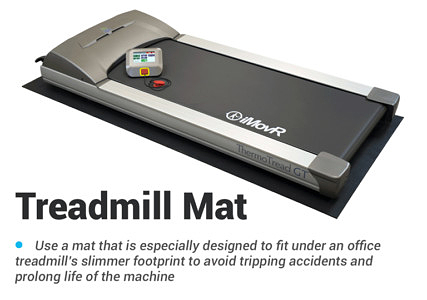

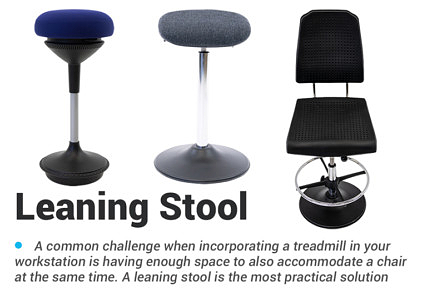
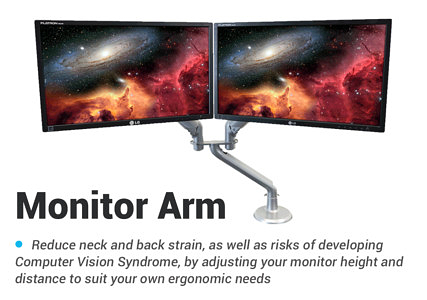
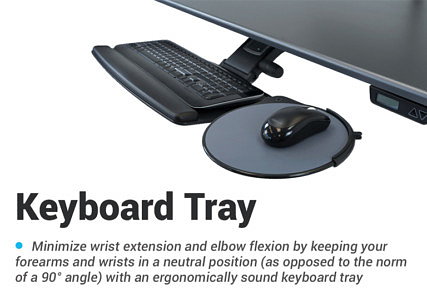
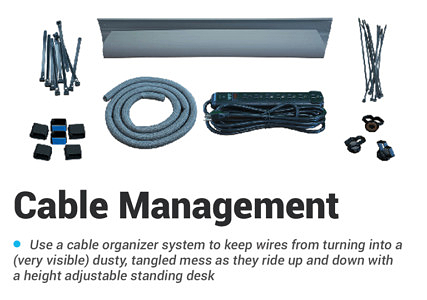
5 Comments
Leave a response >